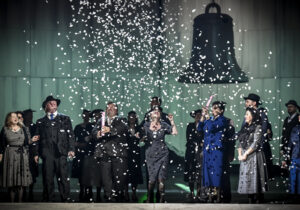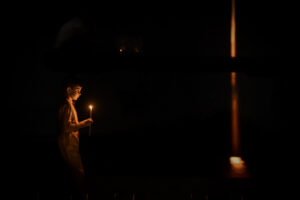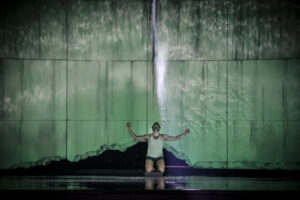Father Fotis, the priest of the Greek refugees from Kazantzakis’ novel Christ Recrucified, once dozed off for a moment and in a dream short like a flash lived at least a thousand years. He dreamed about a canary-like yellow bird which he had begun to pursue as a little boy. In his old age he understood that he would continue to pursue it until his death. He also felt deep down in his soul that the yellow bird, which “sometimes whistled as if it were making fun of him and sometimes, with its head raised towards the sky, sang like mad”, was not, in fact, a canary, but a powerful symbol of faith, hope and determination.
It was Kazantzakis who persuaded Martinů to give up the idea of composing an opera based on Zorba the Greek and to go for his later morality novel. The original Greek title, Ο Χριστός Ξανασταυρώνεται, has a slightly different meaning than “Christ recrucified”. It refers to Christ who has not ceased to be crucified despite the fact that two millennia have passed since his death. The action of the novel takes place in 1921, during the Greco-Turkish War, in a fictitious Greek village in Anatolia where a Passion Play is staged every seven years – featuring actors chosen from among the members of the local community. The villagers traditionally prepare for their roles for months: but this time the process of their identification with the New Testament figures rapidly accelerates. A crowd of hungry, sick refugees from another Greek settlement arrives in the village. Soon an authentic tragedy of agony and death will unfold. The widow Katerina will turn out to be a genuine Mary Magdalene, her lover Panait – Judas incarnate, while Manolios will die like the biblical Christ.
At that time Martinů was approaching the end of his own way of the cross. He left Paris, a city where he had spent nearly twenty years, in 1940, shortly before its capture by the Nazis. First he found refuge in Aquitaine, at the home of the conductor Charles Munch, and then via Spain he reached Portugal, from where he emigrated to the United States. He never truly settled there and intended to return to Czechoslovakia after the war, especially as he continued to receive news of the tragic fate of friends and relatives left behind. In 1946 he suffered an unfortunate accident at his home in Massachussets. The injuries he sustained led to a complete loss of hearing in one ear and irreversible problems with balance. Martinů’s plans were ultimately thwarted by the communists’ takeover of power in his homeland. The ailing composer eventually gave up and applied for American citizenship.
Photo: Marek Olbrzymek
He began to write The Greek Passion in 1954 – the year when Kazantzakis’ novel was published. He worked on the opera for three years and submitted the final version, with his own libretto after an English translation of the novel, to the managers of London’s Royal Opera House, where his compatriot Rafael Kubelík was music director at the time. Despite a favourable decision of the management the premiere did not happen: the allegedly defective score was rejected following an intervention by the composer Arthur Bliss, who was associated with the company. Martinů revised the work thoroughly, making numerous cuts which – paradoxically – destroyed the cohesion of the narrative. He did not live to see the Zurich premiere, as he died two years before it, in 1959. The orphaned Greek Passion soon found its way onto Czechoslovak stages, first in Brno, in 1962, and then in Prague and Bratislava. The work was also staged in several other European countries. The popularity of Martinů’s last opera surged in the 1980s, after the famous Cardiff staging under the baton of Sir Charles Mackerras, who almost simultaneously recorded the entire work with British soloists, the Czech Philharmonic Choir and the Brno Philharmonic Orchestra. It was not until 1999 that the original version was reconstructed, under Aleš Březina’s supervision: the “second” premiere of The Greek Passion took place at the Bregenz Festival. Martinů experienced satisfaction from beyond the grave: the following spring the same production was presented by the ROH.
In many respects Brno can be considered the Czech cradle of The Greek Passion, although not necessarily in the form intended by the composer. The Czechs became accustomed to the Zurich version with the libretto translated into their mother tongue already after the 1961 premiere. They received the reconstructed “London” version with mixed feelings, surprised by the fact that they were dealing basically with a different opera. The creative team of the latest staging at the Janáček Theatre chose a middle way, that is the Zurich version with the English libretto, which again generated some controversy – especially among the advocates of the communicativeness of stage works – justified in so far as the solo parts were cast almost without exception with Czech singers. Yet the premiere was eagerly awaited: owing to the involvement in the venture of Jiří Heřman, a director who already in 2015, shortly after becoming artistic chief of the Brno Opera, had staged The Greek Passion at the Aalto-Musiktheater Essen – with considerable success in the eyes of both the critics and the audience. The pandemic put music lovers to an additional test of patience. The Passion, originally planned for Martinů’s double anniversary, was not staged until November 2021. This year it appeared in Brno on three occasions. I managed to see the last performance.
Photo: Marek Olbrzymek
And it was worth it, if only to marvel again at the visual beauty of Heřman’s concept (which also included light design) prepared in collaboration with set designer Dragan Stojčevski and costume designer Alexandra Gruskova. Heřman “smuggled” into the production several solutions previously tested in Essen – including a huge bell suspended above the stage and a forest of burning candles on the proscenium – yet the Brno staging is far more coherent and bears more marks of the director’s unique style. The colour scheme fluctuates, as usual, between fathomless blacks, broken blue hues and unexpected yellow: that last colour plays the most prominent role in the performance, which is preceded by an extensive quotation from Father Fotis’ dream referred to above. Yellow is the colour of the fire of the paschal candles, the colour worn by both the boy chasing the canary-like bird and Manolios preparing for the role of Christ. Black is the colour of the night of hypocrisy and ignorance, embodied by the attitude of the priest Grigoris, who argues to the village community that if an injustice done to an individual benefits the masses, then it is right. Blue – though at times bordering on grey, at time on green – is the colour of everything that is not obvious. Above all, trees growing with their crowns down, digging their roots into the foundations of houses, as if afraid to go with their shoots outwards, into a world divided by the Greeks into the days before and after the great fire of Smyrna, which ultimately sealed the defeat of their army in 1922 and buried their fantasies about annexing Asia Minor in the dust. What becomes a sign of freedom, faith and hope is the life-giving water on which Manolios walks like Christ – it is admirable how Heřman uses this simple theatrical trick in most of his productions, multiplying the shimmering water in mirror projections in the background.
Heřman’s staging is deeply symbolic, as is Martinů’s opera, in which the composer leaves less room for a play of characters than for a general parable about the power of good and evil, a parable devoid of any historical and political references present in Kazantzakis’ novel. Heřman decided to present The Greek Passion as a universal story set in a vague context, free from any current allusions. I completely understand his decision, especially given the fact that in the light of the latest events the hapless refugees led by Father Fotis would have brought to mind the Russians feeling from the Crimea. In a way, Christ Recrucified is a narrative about the tragedy of the invaders, an poignant parable about the fate of ordinary people caught up in a conflict unfolding above their heads. However, I wish that Heřman had not contented himself with directing crowds, using metaphors without delving into the motivation of the individual characters, who were left to their own devices, at the mercy of their own vocal and acting abilities. I am a little surprised at the optimism of the director, who saw a ray of hope where it was rather absent: in the score and in the last sentence of Kazantzakis’ book, in which the ill-treated community led by Fotis resumed “their interminable march toward the east”.
Photo: Marek Olbrzymek
I think that Heřman’s unrestrained imagination would have had much more opportunity to shine in the original version, more theatrical, brimming with emotion, marked by abrupt changes of mood. The Zurich narrative is dramaturgically lame, seems kaleidoscopic, does not let the audience identify fully with any of the protagonists. This paradox was too much for Robert Kružík, who conducted The Greek Passion with a rather heavy hand and massive sound, stressing the alleged monumentalism of the score, which, in fact, is quite close to Britten’s late operas. He accurately accentuated the austerity of the Greek Orthodox chanting, appreciated the sophisticated stylisation of the folk melody at the beginning of Act III and of the rural wedding music, but lost the tension and poignant lyricism of the late style of Martinů, trapped in his longing for the homeland he never returned to. Kružík did not point the way for the soloists, most of whom created rather flat, one-dimensional characters. He did not breathe passion into the transformation of Manolios, who was sung correctly but without much involvement by Peter Berger. He ignored the sensuality of Katerina as portrayed by Pavla Vykopalova with her soft and colourful soprano. He did not make a distinction between the malefactors and the just, as a result of which a more assured and more memorable voice was that of Father Grigoris portrayed by Jan Šťáva rather than that of Fotis – perhaps more important in the opera than Manolios – sung by the young Moravian bass-baritone David Szendiuch. Who knows, perhaps the performance I will remember the longest was that of the phenomenal Ondřej Koplík in the tenor role of the pedlar Yannakos playing the role of Peter, the most important of the apostles – the one who did not admit to people that he knew Christ.
However, all this will not change the fact that over sixty years after its premiere The Greek Passion strikes chords dull to many recipients of the home-page contents of websites. That it brings to light the bitter truth about the tragedy of all refugees, even if their leaders are on the wrong side. That it explains that Satan can enter only hell, an angel can enter only Paradise and a human being can choose. In spite of everything it does let us hope that human beings will finally make the right choice one day.
Translated by: Anna Kijak



